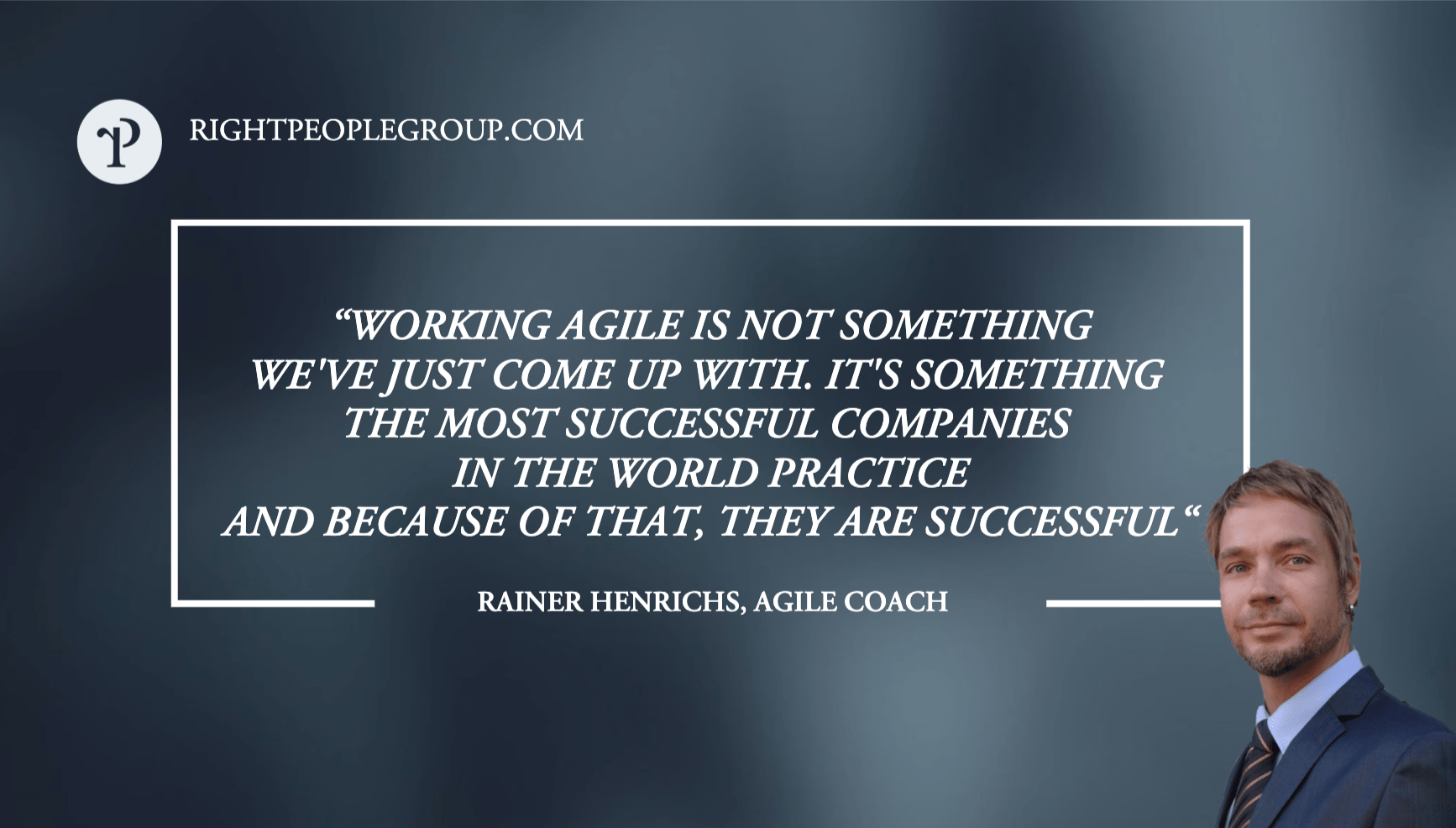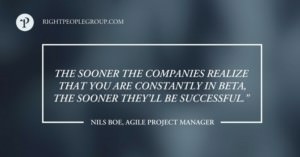For Agile Coach Rainer Henrichs, agile coaching is more than just a job. For him, the expansion of the agile way of working is the raison d’être of his professional existence and a challenge he likes to face every day. While it is rarely easy for a company to transform not only workflows but the entire working culture of the organization, he is convinced that it is worthwhile in every way. In this interview, Rainer Henrichs frankly shares his experiences from a long career in the agile world.
After completing his master’s degree in computer science in California, Rainer Henrichs spent several years working as a java developer. He quickly took on the responsibility for development tasks in the role of a project manager in which he increasingly got to know the advantages of the agile way of working. Since 2011, he supports his international clients as a Scrum Master and Agile Coach in the successful realization of innovative product ideas.
1. How did you end up as an agile coach?
For a long time, I was working in the fields of classic project management. At the time, I already had a very iterative attitude in terms of only planning in detail the tasks that were right in front of my nose, while letting the detail planning of the later stages wait, since you always have to consider the development and the changes that occur anyway. Already while doing traditional project management, this way of thinking helped me, and then, eventually, I came in contact with the agile way of working sometime around 2006. Immediately, it grabbed my attention because it embodied all the elements I believe in.
Since then, I don’t want to do anything else and really do it from the heart. And not because I am some kind of idealist who wants to save the world, but because I believe that it will bring the best results. It’s just more efficient, more fun, and there are fewer things you have to throw away later on.
2. Is the agile way of working meant for everyone? Or is there someone who you would advise against this career path?
There are areas where it is difficult to work in an agile way. Areas that are very heavily regulated, or projects that you simply have to plan in details before you start, e.g. I think it’s difficult to build a house with an agile approach. After finishing the building of the basement, you realize that something had to be done differently to support the fifth floor you need to build. It’s way easier with software because I can change and adapt things once I know what needs to be built.
“It’s not about organizing a short stand-up meeting every day or splitting the work into 2-week stages“
– Agile Coach, Rainer Henrichs
3. How would you explain your job as an Agile Coach to a 5-year-old?
That would be quite difficult. Basically, coaching including agile coaching is about asking lots of questions. An Agile Coach questions the status quo always with the aim of improving the work. Why do we do it this way and not otherwise? Is it possible to solve this differently? And then the coach has to provide the assistance accordingly so that the team can develop in the right direction. The Agile Coach always trusts the employees that they are better at designing the technical solution. In that way, it will help in achieving goals, breaking down barriers or removing obstacles.
4. What does a classic day at work as an agile coach look like?
At least the day looks like I have no clue what will happen throughout the day. First, I go to the teams and ask them how everything is going. I offer them to take my help if they need it and then people come to me and say, “This just happened here. How should I proceed? Do you have an idea? or “Can you take the lead here?” Basically, I offer my service. You can see it as Management as a Service or Leadership as a Service.
Sometimes very banal topics also arise like, “Can you organize a meeting for this and that – and can you moderate it?”. Or more demanding topics like, “I have a problem with this other team. They never do what we ask them to do. Can you talk to them?” Then I’ll assign the task to myself and do it.
“For some managers it sounds like: we do what we want. But that’s not true at all“
– Agile Coach, Rainer Henrichs
5. What kind of work would you do as an agile coach? And what is not your responsibility?
I would do almost every kind of work but still prioritize where my help will be most useful. For example, if someone would come and say to me, “I have a great idea! We have to change the framework somehow, but the other people in the team do not want that.” Then, of course, I would first ask, “Did you talk to the other people?” or “Why do they not want to do it? or “Did you get any feedback from the rest of the team?” – and then I would advise solving the problem themselves. If this is being rejected by the others in the team then maybe there is a reason for it.
But when it comes to the fact that you generally cannot develop within the team, then I can be helpful by taking a closer look at the dynamics of the team to see if everyone also has a voice to be heard. That’s why I always listen in order for me to be able to address the problem in the best way possible. I always ask critically to find the reason for why the team needs my help and of course, I also evaluate who I think is the right person for a given task.
6. How do you as an agile coach work together with scrum masters, or do you also take on the role of a scrum master yourself?
That varies a lot. In the past, as an agile coach, I personally took on teams as a scrum master and then moderated the entire ceremonies myself, such as reviews and retrospectives. But as an agile coach, I also took on the task of coaching the scrum masters and introducing the scrum master to the teams. It highly depends on what level you are currently working on.
7. Do you see it as the goal of your work to make yourself redundant?
Yes, I would generally see it that way. There is always a lot to do at the beginning of a project. When the project starts to develop, people I coached can take over the full responsibility of the project. From there on, I basically see myself as the contact person that can take over when new projects and teams arise.
8. When do you believe this state is reached? How will the team work after that state is reached?
I would say it’s when the team simply start to organize the meetings themselves and everyone feels responsible in the team. Then I realize that they have taken on the responsibility for not only product development but also for constantly evolving. All team members are now thinking about how they can get better and develop together as a team. When this happens, I personally think that you have actually made it as an agile coach.
“If you don’t learn from your mistakes, you make them twice“
– Agile Coach, Rainer Henrichs
9. What are the most common challenges that you encounter as a coach?
In many cases, it’s the management that is suspicious of the agile approach. In agile we propagate self-organized teams and for some managers, this sounds like: we do what we want. But that’s not true at all. There is always a product owner who says what to do and an agile coach that helps to ensure that the work is carried out efficiently.
But there is somehow a lack of control. The partial results are no longer checked. You no longer measure whether an employee did this or that, but only focus on the added value at the end of a sprint. That’s what makes many managers suspicious and some have a problem finding their own role in it. What is the role of a manager when the teams work independently? In the sense of an agile leader, management is more than just servant leadership. Instead of directing and controlling work, they must clearly communicate expectations and goals and then support the teams in achieving them.
It must be acceptable to make mistakes, because only then can the teams learn and further progress. You should try something out and then we have to make sure that the mistakes can be quickly fixed so that no disaster is triggered. Everybody learns from small mistakes and that’s why I cannot come and punish people. Instead, I have to say, “Making one mistake is no problem, but do not make them twice”. We always have to learn from the mistake made. When the lived culture becomes part of the company, everything is actually fulfilled. The big challenge is to make everyone believe in this and to take everyone along the way, not just the team, but also the management and top management.
10. How do you manage to do that then?
First of all, I have to make clear that working agile is not something we’ve just come up with. It’s something that the most successful companies in the world practice and because of that they are successful. To prove the people that the agile way works, I need a small leap of faith. For this, you have to work hard with a trustworthy presence and by delivering again and again.
11. How do you deal with employees who have worked with the waterfall approach for ages and now all of a sudden have to adapt to the agile way of working?
Most importantly is for everyone to understand the reason why we work agile and what it means for the further development of the team. It’s not about organizing a short standup meeting every day or splitting the work into 2-week stages. But instead, I always start by explaining the core values of the agile world: Respect, Openness, Focus, Commitment, and Courage. Then I specify with the team whether everyone stands behind them and finally how exactly we want to implement them in the team.
The team should only consist of people who want to live the values and I support anyone who wants to learn this. Depending on the task of the team, I introduce appropriate procedures such as Scrum and Kanban and together with the team I decide how to start. Sometimes there happen to be people that simply don’t want to learn the agile way of working. In this case, I’m powerless and the only possibility is that this person goes out of the agile team and does something else or works in another company.
“You are only able to get motivation through purpose”
– Agile Coach, Rainer Henrichs
12. Frederic Laloux describes in his book “Reinventing Organization” 3 essential elements of modern companies: Self-management, Purpose, and Wholeness. Does purpose play a role in the agile way of working?
Absolutely. As far as purpose is concerned, the first thing I do with every team I coach is to talk about purpose. Everyone in the team has to know what he or she is there for and what the team is there for. What is the vision of the company and what part of the vision is the mission for our team? That’s really important for the motivation of the employees.
I discuss this with the product owner, and he always has to explain why we do things. Instead of saying, “we have to develop this new feature because the CEO just told me to,” he has to explain it like, “we want to attract new customers here and there,” and that’s why we need this new feature. By changing to this approach, each individual employee gets a completely different relation to the task and also different creativity for finding a solution. You only get motivation through purpose.
Tell us what you need
Let us know what you are looking for and receive CVs of 2-3 independent contractors with skills that match your needs.
Our pricing
Our service of helping you find the ideal consultant for your project is free of charge, with no obligations.
Right People Group only charges you if you hire one of the consultants we present.
Our prices are low for the quality we deliver. This is partly because our business model is efficient. It’s also because we always deliver the best solution in the market in terms of quality and price.
How we select your consultants
Here’s how we get you the right consultant.
Step 1 | Focus on goals We create anonymous job descriptions to attract applicants who are focused on project goals and objectives. |
Step 2 | Maximize reach We search through our network of segmented databases and referrals, and conduct searches on recruitment platforms and marketplaces. |
Step 3 | Selection We filter through potential candidates to find consultants with qualifications and experience that match your expectations. We also look for patterns that indicate high performance, such as long-term relationships and repeat projects. |
Step 4 | Screening We interview candidates to ensure that the candidate’s skills and personality will be the right fit for you. |
Step 5 | Delivery We handpick and deliver profiles of the best candidates. In case a consultant goes sick or doesn’t work out, we find a replacement right away. |
Are you a consultant?
Sign up to join our consultant network.
We’ll email you projects that are relevant to your profile as soon as they become available.










